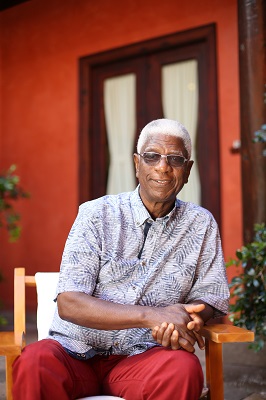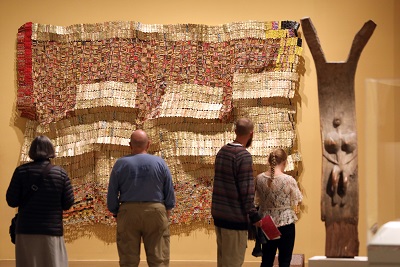The 29th
LaureateSculpture
El Anatsui

El Anatsui’s complex artwork defies traditional categories. He is well known for malleable sculptures created from discarded metal,such as cassava graters or liquor bottle tops. Often large in scale,their size and luminous nature can render them immersive. His transformation of these found materials enhances their significance and imbues them with a certain dignity – something he deeply values. His long held opinion is that “art is something that grows from the environment,it is not something you have to create.” Born in Ghana,he moved to Nigeria in 1975,where he is based today. He has been collected by major international museums,including the Metropolitan Museum of Art,the Tate Modern,the Centre Pompidou and the Smithsonian Institution,among many others. In 2015,he was awarded the Golden Lion for Lifetime Achievement at the Venice Biennale. He was the subject of large-scale retrospective in Japan that traveled to several venues (2010-11). In 2015,a major work was included in the exhibition The Contemporary 2: Who Interprets the World? at the 21st Century Museum of Contemporary Art,Kanazawa,Japan. He is the first Ghanaian recipient of the Praemium Imperiale.
Biography
El Anatsui is an internationally acclaimed artist who transforms basic components into complex compositions. He often uses materials that are typically discarded,such as liquor bottle caps and cassava graters,to create sculpture that defies categorization. His use of these elements reflects his interest in reuse,transformation,and an intrinsic desire to connect to his continent while transcending the limitations of place. In a recent interview,Anatsui said that “art grows from the environment. Even if you don’t have the money to buy oil colors,there are so many sources of colors all around you,” This resourceful philosophy is incorporated throughout his work.
Born in Ghana in 1944,Anatsui studied sculpture at its University of Science and Technology. In 1975,he moved to Nigeria to take the post of professor of art at the University of Nigeria,Nsukka. Anatsui first received renown for ceramic works,such as the Broken Pots series,which reimagined ceramic and manganese vessels,denying their usability. His destruction and reassembly of familiar objects and a focus on materiality would become an important anchor of his practice,as would the investigation and complication of symbols. In the 1980s and 90s,Anatsui became well known for wooden works that bore the marks of extreme process and were often assembled in interlocking panels. Often singed,burnt,hacked or sawn,the drama of their making contrasted with intricate patterns,subtle gradations in color,and delicate populations of markings. Other wooden works had heavy intaglio lines and flashes of paint,which found kin with bold-banded acrylic paintings and etchings from the same time.
The tension between fragility and resilience inherent in the medium of clay,and the radical formal properties of the wood work that often included dynamic grid-like patterns,can be seen in the majestic metal wall-hangings for which Anatsui is best known. Meticulously assembled from discarded aluminium often sourced from liquor bottles,recycled materials coalesce in exquisite constellations that track postcolonial exchange and global traditions of abstraction. Delicate yet monumental,hovering between sculpture and painting,the metal constructions defy categorization and have solidified Anatsui’s status as a ground-breaking visual artist of international critical acclaim.
Anatsui has been featured in many international exhibitions and has had several major retrospectives and surveys of his work travel throughout the United States,Japan and Australia. His work is included in major museum collections,such as the Centre Pompidou in Paris,the Metropolitan Museum of Art and MoMA in New York,and the Tate Modern and British Museum in London. Recent large scale public installations include Broken Bridge II,commissioned by High Line Art and presented by Friends of the High Line in New York (2012-2013),and Tsiatsia – Searching for Connection,installed on the façade of the Royal Academy of Arts in London in 2013.
Anatsui’s work reflects his cultural experiences and the visual influences that surround him,yet is keen to ensure that his work is not categorized as “African Art.” “I’m just an artist. There’s no African football. Football is football. People say Japanese art,African art,etc. but art is art. You don’t have to define it geographically.”
In 2015,he was awarded the Golden Lion for a Lifetime Achievement at the Venice Biennale. He is the first Ghanaian recipient of the Praemium Imperiale.
Chronology
Began to teach at Winneba Special Training College,Ghana
Included in the 8th Osaka Sculpture as well as An Inside Story,which opened at the Setagaya Art Museum,Tokyo and traveled to five additional Japanese museums,concluding at the Museum of Fine Arts,Gifu,in 1996
Included in the Gwangju Biennale,South Korea
Included in both the Paris Triennale and the Sydney Biennale
Golden Lion for Lifetime Achievement at the 56th Venice Biennale,Italy
-

Tenerife, Canary Islands
-

Adinkra Sasa
-

Between Earth and Heaven
-

Bukpa Old Town
-

Award ceremony of Premio Brote Artístico 2017
-

Tenerife, Canary Islands

